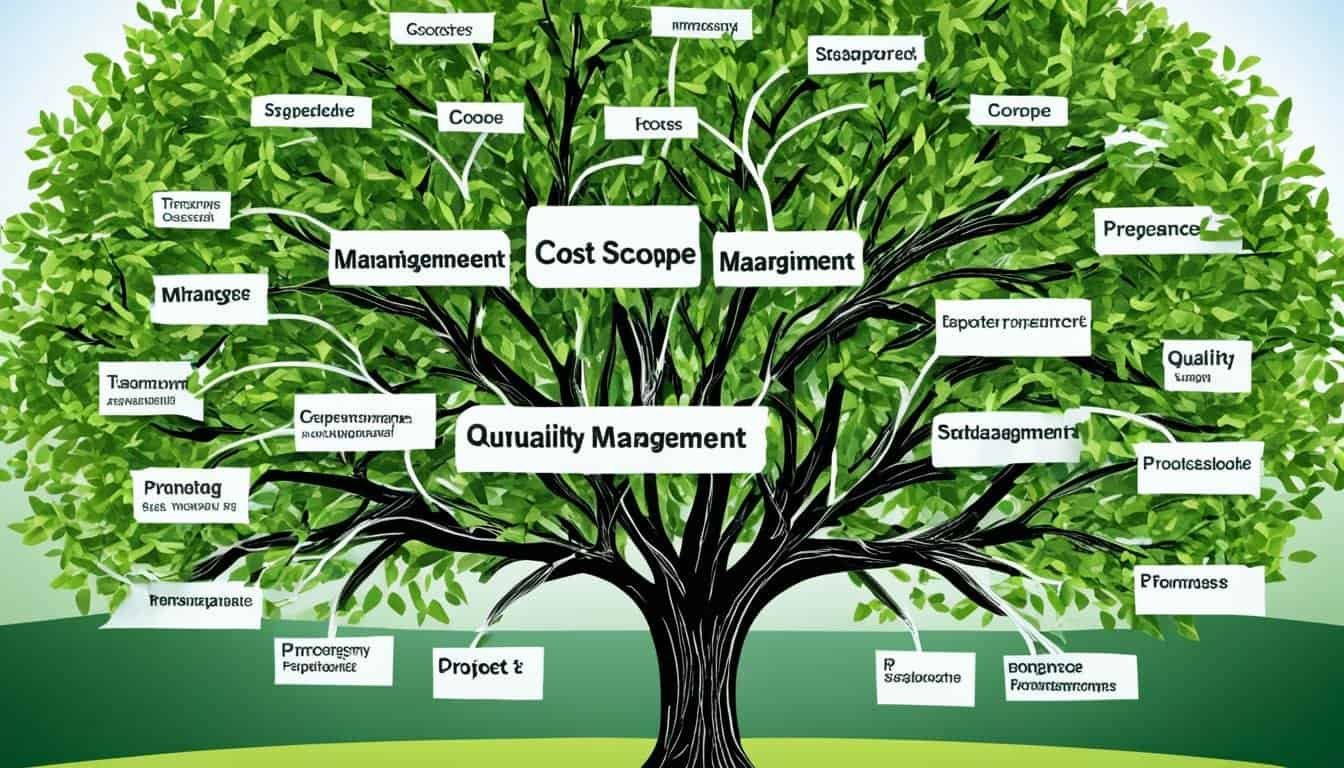Key Performance Areas for Project Managers Guide
Welcome to our comprehensive guide on key performance areas for project managers. As a project manager, it is crucial to possess a diverse set of project management skills and knowledge to successfully navigate project planning, stakeholder management, resource allocation, risk management, project execution, project monitoring, performance evaluation, and project communication.
Project managers play a critical role in ensuring the success of projects by overseeing various aspects throughout the project lifecycle. By focusing on key performance areas, project managers can effectively track the progress and performance of their projects, identify potential challenges, and make informed decisions to drive the project towards success.
Key Takeaways:
- Project managers must possess a diverse set of skills to excel in various key performance areas.
- Key performance areas for project managers include project planning, stakeholder management, resource allocation, risk management, project execution, project monitoring, performance evaluation, and project communication.
- Continuous monitoring and evaluation of project performance are crucial for driving project success.
- Effective project management involves aligning strategic objectives with key performance areas.
- By setting clear and focused KPIs, project managers can track progress and make data-driven decisions.
Understanding the Importance of Project KPIs
Key performance indicators, or KPIs, play a vital role in measuring the success of a project. While traditionally, time and budget were considered the main determinants of project success, today’s project managers rely on a diverse range of KPIs to assess project performance. These KPIs fall into four categories: timeliness, budget, quality, and effectiveness. By utilizing KPIs, project managers can track progress, ensure efficient resource allocation, manage budgets effectively, maintain quality control, and evaluate the overall effectiveness of the project.
“Having well-defined KPIs is essential for project managers to monitor and evaluate project performance accurately. These indicators provide a clear set of goals and metrics that help guide decision-making and ensure that project objectives are met.”
When it comes to project success, key performance indicators act as crucial benchmarks. By tracking timeliness KPIs, project managers can evaluate whether the project is progressing within the established timeline and meeting specific deadlines. Budget KPIs enable project managers to effectively manage resources and allocate budgets according to project goals. Quality KPIs help maintain the desired standards by evaluating the level of product or service quality. Finally, effectiveness KPIs provide insights into how well the project aligns with strategic objectives and achieves desired outcomes.
Here is a breakdown of the four categories of project KPIs:
- Timeliness KPIs: helps project managers monitor project progress and ensure that it stays on track with the established schedule. Examples include project schedule adherence, on-time completion percentage, and milestone achievement rate.
- Budget KPIs: assists in monitoring and managing project budgets effectively. Examples include budget variance, cost deviation, and planned value versus actual cost.
- Quality KPIs: measures the level of quality control and ensures that the project deliverables meet the expected standards. Examples include customer satisfaction levels, the number of errors or defects, and the compliance rate with quality standards.
- Effectiveness KPIs: assesses the project’s overall effectiveness in achieving its goals and strategic objectives. Examples include resource capacity utilization, stakeholder satisfaction levels, and return on investment (ROI).
By utilizing these diverse KPIs, project managers can gather valuable insights into different aspects of project management. These indicators enable data-driven decision making, help identify areas of improvement, and drive project success.
The Benefits of Project KPIs
Implementing and utilizing project KPIs offer several benefits that contribute to project success:
- Measurable Project Goals: KPIs provide clear metrics to measure project performance against established goals, ensuring alignment with desired outcomes.
- Resource Allocation: By tracking KPIs, project managers can efficiently allocate resources to tasks and areas where they are most needed, maximizing efficiency and productivity.
- Budget Management: KPIs related to project budgets enable effective cost control, helping project managers stay within the allocated budget and avoid overspending.
- Quality Control: KPIs focused on project quality help identify areas for improvement and ensure that deliverables meet or exceed expectations.
- Evaluation of Effectiveness: Through effectiveness KPIs, project managers gain insights into how well the project contributes to strategic objectives, enabling them to make informed decisions.
Overall, understanding and utilizing project KPIs is crucial for project managers to drive project success, monitor progress, and take proactive measures to achieve desired outcomes. By leveraging these indicators effectively, project managers can enhance efficiency, improve decision-making, and achieve the desired results.
Tips for Creating and Using Project KPIs Effectively
Creating and using project Key Performance Indicators (KPIs) effectively is essential for project managers. By implementing SMART KPIs, project managers can set clear and focused targets that align with the organization’s strategic objectives. SMART stands for Specific, Measurable, Attainable, Relevant, and Time-bound, ensuring that KPIs are well-defined and actionable.
When setting KPIs, it’s important to identify the most important measures that will drive project success. These measures should directly contribute to the achievement of strategic objectives and reflect the priorities of the project. By selecting the right KPIs, project managers can stay focused on what truly matters.
“Setting clear objectives is the key to success. You can’t hit a target you can’t see.” – Brian Tracy
In addition to selecting the right KPIs, project managers should also set targets for each KPI. Setting targets helps create milestones and benchmarks for progress, providing a sense of direction and purpose. These targets should be specific and measurable, allowing project managers to track progress effectively.
Once the KPIs and targets are established, project managers should regularly track the progress towards those targets. This ensures that the project stays on track and any deviations or issues can be identified and addressed promptly. Tracking progress allows project managers to make data-driven decisions and take corrective actions when necessary.
Remember, effective project KPIs provide valuable insights into the project’s success and performance. By following these tips and implementing SMART KPIs, project managers can enhance their ability to measure and monitor project progress, ultimately driving project success.
Key Project Management KPIs
When it comes to project management, measuring the success of a project is crucial. Key Performance Indicators (KPIs) provide valuable insights into different aspects of project management and help project managers make informed decisions. Here are some key project management KPIs that every project manager should track:
1. Timeliness KPIs
Timeliness KPIs are essential for measuring the project’s adherence to the project schedule and ensuring on-time completion. Some important timeliness KPIs include:
- Project Schedule: This KPI tracks the progress of the project against the planned schedule, ensuring that tasks are completed on time.
- On-time Completion Percentage: This KPI measures the percentage of tasks or milestones that are completed within the scheduled time frame.
2. Budget KPIs
Managing the project budget is crucial for the overall success of the project. Here are some key budget KPIs to monitor:
- Budget Variance: This KPI measures the difference between the actual costs and the projected budget, helping project managers identify budget overruns or savings.
- Cost Performance Index: This KPI compares the value of the work performed to the actual cost, indicating the project’s expense efficiency.
3. Quality KPIs
Ensuring high-quality project outcomes is a top priority for project managers. Here are some quality KPIs to assess:
- Customer Satisfaction: This KPI measures the degree of customer satisfaction with the project deliverables or services.
- Employee Churn Rate: This KPI indicates the rate of employee turnover, which can impact the project’s overall quality and performance.
4. Effectiveness KPIs
Effectiveness KPIs evaluate the project’s overall effectiveness and alignment with strategic goals. Here are some key effectiveness KPIs to consider:
- Resource Capacity: This KPI assesses the availability and utilization of resources, ensuring optimal resource allocation.
- Stakeholder Satisfaction: This KPI measures the satisfaction levels of project stakeholders, including clients, team members, and other relevant parties.
Tracking these key project management KPIs enables project managers to gain valuable insights into the progress and success of their projects. By regularly monitoring and evaluating these KPIs, project managers can make data-driven decisions and take appropriate actions to enhance project performance and achieve the desired outcomes.
Managing Project Budget KPIs
Managing project budget KPIs is crucial for project managers to ensure that the project stays within the allocated budget. By closely monitoring and analyzing key budget KPIs, project managers can effectively track and control project expenses, making necessary adjustments to avoid overspending. Let’s take a closer look at some of the essential budget KPIs that project managers should focus on:
Budget Variance
The budget variance measures the difference between the actual and projected budgets. It provides project managers with insights into whether the project is over or under budget and helps identify areas that require cost-saving measures or additional funding.
Budget Creation Cycle Time
The budget creation cycle time measures the time required to create a comprehensive budget for the project. By reducing the cycle time, project managers can allocate more time to other critical project activities and ensure that the budget is approved promptly.
Line Items in Budget
Tracking the line items in the budget allows project managers to monitor individual expenditures and identify potential areas of overspending. By closely managing each line item, project managers can make informed decisions and prioritize spending to maximize the project’s value.
Number of Budget Iterations
The number of budget iterations refers to the number of versions of the budget that go through revision and approval before finalization. Project managers should aim to minimize the number of iterations, as excessive revisions can delay the project’s progress and increase administrative overhead.
Planned Value
The planned value of the project measures the value of the remaining work based on the approved budget. It provides project managers with a clear understanding of the project’s progress and allows for better resource allocation and prioritization of tasks.
Cost Performance Index
The cost performance index (CPI) evaluates the expense efficiency of the project by comparing the actual cost of work performed to the planned cost. A CPI value greater than 1 indicates that the project is performing well within the budget, while a value less than 1 indicates cost overruns.
By effectively managing these budget KPIs, project managers can ensure financial discipline, make data-driven decisions, and optimize project outcomes. Let’s explore these KPIs further with the help of the table below:
| Key Budget KPIs | Description |
|---|---|
| Budget Variance | Measures the difference between actual and projected budgets. |
| Budget Creation Cycle Time | Measures the time required to create a comprehensive budget for the project. |
| Line Items in Budget | Helps track individual expenditures and prioritize spending. |
| Number of Budget Iterations | Measures the number of versions of the budget before final approval. |
| Planned Value | Measures the value of remaining work based on the approved budget. |
| Cost Performance Index | Measures the expense efficiency of the project. |
With a comprehensive understanding of these budget KPIs, project managers can effectively manage project costs, ensure financial control, and drive project success.
Tracking Project Schedule KPIs
Tracking project schedule KPIs is vital for project managers to ensure that the project stays on schedule. By monitoring key schedule indicators, project managers can proactively identify areas that require adjustment and take appropriate measures to mitigate risks and delays. Let’s explore some essential project schedule KPIs:
Schedule Performance Index (SPI)
The Schedule Performance Index (SPI) is a valuable metric that measures the progress of the project compared to the planned schedule. It helps project managers assess how efficiently the project team is progressing and whether they are meeting the established milestones and deadlines. SPI is calculated by dividing the earned value (EV) by the planned value (PV), providing insights into the project’s schedule efficiency.
Schedule Variance (SV)
The Schedule Variance (SV) measures the difference between the planned schedule and the actual progress of the project. It indicates whether the project is ahead of schedule or behind schedule. A positive SV indicates that the project is ahead of schedule, while a negative SV suggests delays. By monitoring SV, project managers can identify potential bottlenecks and take corrective actions to keep the project on track.
Resource Capacity
Resource capacity is a crucial aspect of project schedule management. It refers to the availability and allocation of resources required to complete project tasks within the planned schedule. By effectively managing resource capacity, project managers can ensure that resources are appropriately distributed, minimizing potential delays and optimizing productivity.
Percentage of Milestones Missed
The percentage of milestones missed is an insightful KPI that reflects the level of achievement of project goals and milestones. It provides a measure of the project’s progress and helps project managers identify any lagging areas. By analyzing the percentage of milestones missed, project managers can take corrective actions to realign the project with the planned schedule and ensure successful project delivery.
Monitoring and leveraging these project schedule KPIs empower project managers to make data-driven decisions, effectively allocate resources, and keep the project on track. Let’s take a look at a comprehensive table summarizing these key project schedule KPIs:
| KPI | Description |
|---|---|
| Schedule Performance Index (SPI) | Measures the progress efficiency of the project compared to the planned schedule. |
| Schedule Variance (SV) | Quantifies the difference between the planned schedule and the actual progress of the project. |
| Resource Capacity | Refers to effectively managing the availability and allocation of resources required for project tasks. |
| Percentage of Milestones Missed | Indicates the level of achievement of project goals and milestones. |
Assessing Project Quality KPIs
Assessing project quality is fundamental to ensuring high-quality project outcomes. By measuring key performance indicators (KPIs) related to customer satisfaction, stakeholder satisfaction, net promoter score, number of errors, customer complaints, and employee churn rate, project managers can gain valuable insights into the quality of their projects.
Customer satisfaction is a crucial KPI that measures the satisfaction levels of customers or clients. By gathering feedback and assessing customer satisfaction, project managers can identify areas for improvement and ensure that their projects meet or exceed customer expectations.
Stakeholder satisfaction is another essential KPI that measures the satisfaction levels of all project stakeholders, including team members, sponsors, and other key individuals involved in the project. By prioritizing stakeholder satisfaction, project managers can build strong relationships, foster collaboration, and enhance project success.
Net promoter score (NPS) is a widely used KPI that measures brand loyalty and customer satisfaction. It provides valuable insights into the level of customer advocacy and can help project managers gauge the overall success and impact of their projects.
The number of errors is a critical KPI that measures the frequency of reworks and revisions in a project. By tracking and minimizing errors, project managers can improve project efficiency, reduce costs, and deliver higher-quality outcomes.
Customer complaints are important KPIs that measure customer dissatisfaction. By addressing and resolving customer complaints promptly, project managers can maintain good client relationships, enhance project outcomes, and mitigate potential risks.
Employee churn rate is an essential KPI that indicates the level of employee turnover within a project. By monitoring and managing employee churn rate, project managers can identify any underlying issues, improve team morale, and ensure a stable and productive project environment.
Measuring project quality KPIs helps project managers identify areas for improvement, make data-driven decisions, and take proactive actions to ensure high-quality project outcomes.
By assessing these key quality KPIs, project managers can gain a comprehensive understanding of the quality of their projects and make informed decisions to improve project outcomes. The next section will focus on evaluating project effectiveness KPIs, highlighting the factors that contribute to the overall success and effectiveness of a project.
Evaluating Project Effectiveness KPIs
Evaluating project effectiveness key performance indicators (KPIs) is crucial for project managers to assess the overall performance and success of their projects. By analyzing these KPIs, project managers can gain valuable insights into the project’s efficiency, profitability, and alignment with strategic goals. Let’s explore some key effectiveness KPIs that project managers should consider:
Average Cost per Hour
The average cost per hour is a vital KPI that measures the effort required to complete a project. By analyzing this metric, project managers can assess the project’s resource utilization and identify any potential cost inefficiencies. It helps to track and manage project expenditures effectively.
Resource Profitability
Resource profitability is an essential KPI for evaluating the financial returns of the resources utilized in a project. By examining this metric, project managers can determine whether the resources allocated to the project are generating the expected profits. It enables project managers to make data-driven decisions regarding resource allocation and optimize resource utilization.
Return on Investment (ROI)
Return on investment (ROI) is a key KPI that measures the financial returns generated by the project. By calculating the ROI, project managers can assess the project’s overall profitability and weigh it against the initial investment. It helps project managers make informed decisions about resource allocation, budget management, and project prioritization.
Productivity
Productivity is a critical KPI that measures the efficiency of project outcomes. By evaluating productivity metrics, project managers can determine the project’s ability to deliver desired results within the allocated resources, time, and budget. It helps identify any bottlenecks or areas for improvement, enabling project managers to optimize processes and enhance productivity.
Alignment with Strategic Goals
Alignment with strategic goals is a crucial KPI that measures the extent to which the project contributes to the organization’s overall strategic objectives. By assessing this metric, project managers can ensure that their projects are aligned with the organization’s larger goals and vision. It allows project managers to prioritize projects based on their strategic significance and make informed decisions that drive the organization’s success.
By evaluating these key project effectiveness KPIs, project managers can gain comprehensive insights into the project’s performance, efficiency, and strategic impact. These metrics provide valuable information for making data-driven decisions, optimizing resource allocation, and driving project success.
Importance of Continuous Monitoring and Evaluation
Continuous monitoring and evaluation are crucial for project managers to ensure the success of the project. By continuously monitoring project performance and evaluating the progress, project managers can make data-driven decisions and take corrective actions if necessary. This ongoing evaluation process helps project managers identify potential issues and make timely adjustments to ensure project success.
Benefits of Continuous Monitoring and Evaluation
Continuous monitoring and evaluation provide several key benefits for project managers:
- Improved Project Performance: By regularly monitoring project performance metrics, project managers can identify areas of improvement and implement necessary changes to enhance project efficiency.
- Enhanced Decision Making: Data-driven decision making is essential in project management. Continuous monitoring and evaluation provide project managers with accurate and up-to-date information, enabling them to make informed decisions based on real-time insights.
- Early Issue Detection: Continuous monitoring helps project managers identify potential issues and risks early on, allowing them to proactively address challenges before they escalate and impact project success.
- Optimized Resource Allocation: By continuously evaluating project performance, project managers can assess resource usage and make necessary adjustments to optimize resource allocation, ensuring resources are utilized efficiently to achieve project goals.
Project success relies on continuous monitoring and evaluation to track progress, identify areas for improvement, and ensure the project remains on target. Without these essential practices, project managers may overlook critical issues that could hinder project success.
Continuous monitoring and evaluation enable project managers to stay proactive, responsive, and adaptable throughout the project lifecycle. It’s not just about following a plan blindly, but rather about leveraging data to make informed decisions and steer the project towards success.
A Case Study Example Table
| Project | Project Performance | Performance Evaluation | Data-Driven Decision Making |
|---|---|---|---|
| Project A | On-time completion Quality deliverables Effective communication |
Regular performance reviews Feedback from stakeholders Comparing KPIs against targets |
Identified areas for improvement Allocated additional resources Implemented changes in communication strategy |
| Project B | Delays in completion Customer complaints Low stakeholder satisfaction |
Root cause analysis Review of project communication Analysis of resource allocation |
Adjusted project timeline Improved communication channels Reallocated resources for efficient usage |
Note: This is a hypothetical case study example to illustrate the practical application of continuous monitoring, performance evaluation, and data-driven decision making in project management.
Conclusion
In conclusion, effective project management hinges on the identification and management of key performance areas. Project managers must diligently track and evaluate project KPIs related to various essential areas, such as project planning, stakeholder management, resource allocation, risk management, project execution, project monitoring, performance evaluation, and project communication. By paying attention to these critical areas, project managers can ensure that their projects remain on track, meet objectives, and deliver the desired outcomes.
Continuous monitoring and evaluation play a pivotal role in project success. By regularly assessing project KPIs, project managers can make data-driven decisions and take proactive measures to address any issues that may arise. This ongoing evaluation process enables project managers to identify potential risks, bottlenecks, or deviations from the project plan and make timely adjustments to mitigate these challenges. Moreover, it allows them to maintain alignment with the organization’s strategic goals while maximizing overall project efficiency.
Overall, project managers who prioritize key performance areas and maintain a constant focus on monitoring and evaluation are more likely to achieve project success. By applying effective project management skills and utilizing relevant KPIs, project managers can optimize resource utilization, mitigate risks, and enhance project outcomes. Remember, tracking project KPIs is not only essential during the project implementation phase but also throughout its lifecycle to drive continuous improvement and ensure a successful project delivery.







